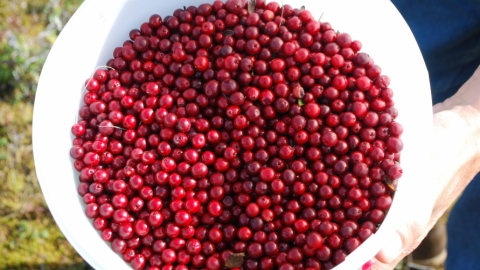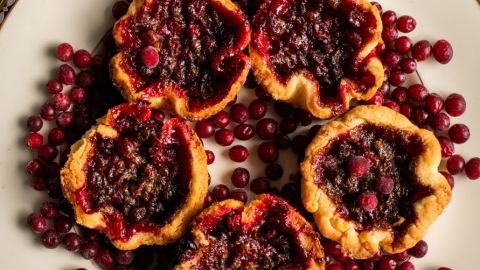Running on Empty
In the Southern Lakes region of the Yukon, 2023 was a bad year for lowbush cranberries. Ditto soapberries. Blueberries in the White Pass en route to Skagway were okay, but just.
That September my partner and I took our dog for a walk up the clay cliffs that line the west side of downtown Whitehorse. It’s a regular walk; we live at the base of the cliffs, underneath the airport and the forest. There is always something interesting to see up there, apart from planes and the sweeping view of the city, the river, and the mountains. Spruce tips coming into bud, roses blooming, juniper berries blue upon the bush, patches of cranberry, and kinnick kinnick. Foxes, coyotes, grouse, and at least once a season, a bear. Or at least bear scat. The forest on the cliffs is a through-passage for the bears, a good source of soapberries, when the soapberries are good.
On that September walk, we turned into the trees from the cliff edge and stopped dead. On the pathway at our feet was a foamy, orange-pink pile. It was like no bear scat we’d ever seen, not the healthy purple-hued heap of the August blueberry patch, nor the seedy soapberry mound typical of this time of year. We got closer, we poked with a stick, discerned scraps of tough skin and bits of flat, rounded seed. We looked at each other. Rose hips. It was such a bad year for berries that the bears were eating rose hips. Like us, they were running on empty.
In 2018 my household did so well on gathering all the berries— raspberries, black currants, blueberries, and lowbush and highbush cranberries—that we bought an extra freezer. The luck continued right through 2022. That year we had enough lowbush cranberries to donate to the hospital and the seniors’ residence for their elder programs; to supply our grandson with berries for his granola bars sold at the family booth at Fireweed Market; to stock up our friends who were (foolishly) traveling during berry season.
In those years, our lowbush cranberry patch never failed to produce bucketfuls of the precious, jewel-like fruits. We took new friends with us (judiciously chosen for their discretion), we ran into the old friends we’d discovered the patch with years before. We built fires by the lake and drank tea and cranberry liqueur, a favorite ritual. Berry picking is about so much more than just the harvest; it’s about reconnecting with each other and the land, tuning into the rhythm of the seasons, touching the earth, and watching the sky.
In September of 2023, fresh from a trip to Ontario, Canada, we heard stories from friends and read on social media about not just the low yield for lowbush cranberries, but no yield at all, throughout the Southern Lakes district, even west into Haines Junction and north to Mayo. Never mind, we thought, our patch will come through. It always does.
We loaded the car with buckets and pickers, with cranberry scones and a Thermos of tea, and drove the familiar route to our spot, confident of success. Ten yards into the woods from the road we knew. There were plants everywhere, their beautiful leaves shining in the sun. But not a single berry. Now and then one of us spied a glow of deep red among the green and caught our breath, but alas, it was only a leftover berry from last year. We came home with empty buckets and bleak hearts.
Our loss of last year was not life threatening, or as yet, life changing. But it did serve, in our relatively privileged lives, as a graphic reminder of what loss of habitat or loss of access to the foods of the wild means to Indigenous peoples who depend on those foods not just for sustenance but also for connection to ancient rhythms and ways of living. As Vuntut Gwich’in Elder Elizabeth Kyikavichik of Old Crow recently said to me, “Berry picking is our way of finding peace.”
In January 2023 a study published in Botany magazine revealed that certain berries were indeed in decline in parts of the Yukon. Co-authored by scientists based in British Columbia, the Yukon and Ontario, “Trends in groundberry cover under climate change in the southern and central Yukon, 1997–2022” considered berry cover rather than berry count based on test sites set up near Whitehorse and Mayo, and in Kluane. It focused on five groundberries familiar to northerners: kinnick (Arctostaphylos uva-ursi), red bearberry (Arctostaphylos rubra), crowberry (Empetrum nigrum), toadflax (Geocaulon lividum), and, of most interest to humans, lowbush cranberry (Vaccinium vitis-idaea). Of the five berries, four were found to be in decline, cumulatively, about 10 percent per decade. Only lowbush cranberry cover increased during the study period. Interestingly, the study’s co-authors did not find a correlation between climactic variables—temperature and rain—and increase or decrease in groundberry cover. They didn’t know exactly why the appreciable variations in quantity have happened. The authors noted that given the role of groundberries in the boreal forest, and their importance to wildlife and humans, gaining a better understanding is key. Ideas for more on-the-ground and laboratory research, discussed in the study, include experimenting with light, temperature, and moisture to discover what is driving the change.
Meanwhile, our on-the-ground experience of last year doesn’t reflect the trend in lowbush cranberries the authors found. The berry count in our freezer is in decline. As I write, the harvest of 2024 is an unknown. The raspberries, though, are looking good in the alleys of downtown Whitehorse. Maybe that augurs well for the other berries. But until we see what the harvest will be, we are being careful in our cooking, focusing on recipes that use few berries in proportion to recipe yield. Recipes that highlight their bright, berry flavor allow us to savor the gift, and meditate on its importance in our lives. We’re not taking anything for granted.
Recipes for a Lean Berry Year
Cranberry Juice
Cranberry Ripple Gelato
Blueberry Lemon Biscotti
Cranberry Bourbon Hot Toddy
This originally appeared in Issue 33, Fall 2024







